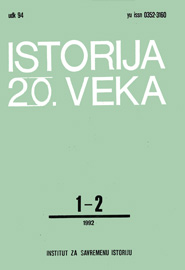RIMOKATOLIČKE DIJECEZE U KRALJEVINI JUGOSLAVIJI - CRKVENO MEĐUDRŽAVNO RAZGRANIČENJE I OBRAZOVANJE NOVIH DIJECEZA
ROMAN CATHOLIC DIOCESES IN THE KINGDOM OF YUGOSLAVIA - CHURCH INTERSTATE DIVISION AND THE FORMATION OF NEW DIOCESES
Author(s): Nikola ŽutićSubject(s): Christian Theology and Religion, History of Church(es), Geography, Regional studies, Recent History (1900 till today), Pre-WW I & WW I (1900 -1919), Interwar Period (1920 - 1939), Eastern Orthodoxy
Published by: Institut za savremenu istoriju, Beograd
Keywords: Roman catholic dioceses; Kingdom of Yuguslavia; Church; interstate division; formation of new dioceses; Vatican; Concord of 1914;
Summary/Abstract: The borders of the Kingdom of the Serbs, Croats and Slavonians cut through the territory of several formerly united Roman Catholic dioceses. The formation of the Yugoslav state caused the old Austrian and Hungarian dioceses to be Split up and reduced in size. Wishing to ensure sovereignty of the state, Yugoslav governments strived to annex parts of foreign dioceses to existing Yugoslav bishoprics, or to have them organized as independent dioceses (apostolic administrations). The Vatican, on the other hand, endeavored to postpone as much as possible the separation of foreign and Yugoslav dioceses. However, in cases where parts of Yugoslav bishoprics were to be connected to Italian ones (for example, when C. Constontini was appointed apostolic administrator of Rijeka in 1920), the Vatican readily gave its full approval. Church interstate division began in 1923 when apostolic administrations were established for Banat and Bačka, and when Baranja, parts of Slavonia, Međumurje and annexed to Yugoslav church regions. On the other hand, parts of Yugoslav dioceses were connected to those of Italy (Rijeka, Zadar, parts of the Bishopric of Krk etc.). Church division between Albania and the Kingdom of the Serbs, Croats and Slovenians was never carried out and, consequently, foreign Franciscans served in border regions of Montenegro and Metohija. In some parts of the Kingdom of the Serbs, Croats and Slovenians regular church administration was never set up (Serbia and Macedonia). The 1914 concord between the Kingdom of Serbia and the Vatican stipulated the founding of a Bishopric of Belgrade and a suffragan diocese of Skopje. However, the establishment of regular hierarchy and administration was put off for a long time. Belgrade and Serbia represented only a Catholic mission under the jurisdiction of the Congregation for the Propagation of the Faith. In Belgrade things remained at the level of»a Catholic missionary with the jurisdiction of a parish priest», since the parish priest wagner administered the Belgrade parish and took care of the Roman Catholics in Serbia. Regular church hierarchy was established only in the autumn of 1924 with the appointment of R. Rodić as the Archbishop of Belgrade,
Journal: Istorija 20. veka
- Issue Year: 1992
- Issue No: 1+2
- Page Range: 73-82
- Page Count: 10
- Language: Serbian

